Anne is the curator of Social and Oral History at the National Coal Mining Museum at Caphouse Colliery which stopped production in 1985. Initially the site was known as the Yorkshire Mining Museum but in 1995 it became the National Coal Mining Museum for England.
Anne’s talk was based on an exhibition held in 2006 at the museum about 5 mining disasters . All the information in the exhibition was gained from reports or accounts by relatives of the victims of the disasters and by doing this it allowed the local community around Caphouse to feel involved.The pit disasters used in the exhibition were:
- Huskar Pit, Yorkshire – 1838
- Hartley Colliery, Northumberland – 1862
- Minnie Pit, Staffordshire – 1918
- Creswell Colliery, Derbyshire – 1950
- Lofthouse Colliery, Yorkshire – 1973
Coal mining was a major industry in the UK until the miners’ strike in 1984 – 1985 and the industry was one of the largest employers in Yorkshire up to that date. It is hard to imagine but there are more than 1,500 shafts and bell pits within a 5 mile radius of the museum.
Huskar Pit Disaster – 1838.
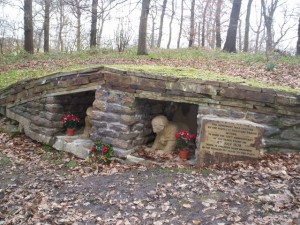
Up to 1842 both women and children worked in the mines alongside the men. The men dug the coal, the women put it into baskets for the boys to fill the tubs. Very young boys worked as trappers, opening and closing ventilation doors and the older boys pulled and pushed the tubs.
On the 4th July 1838 26 children died, mostly under the age of 12 due to flooding. There was a storm and a stream overflowed and caused the flooding. The children were told to stay where they were, but when the lights went out they panicked and 40 of them decided to get to the surface by a day – hole. 4 escaped but the other 26 were trapped and drowned.
The 1842 Mines and Collieries act banned all women and boys under the age of 10 working underground, but there was only one inspector to see that the law was being obeyed.
Hartley Colliery Disaster – 1862.
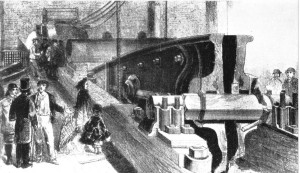
On the 16th January 1862 a beam weighing more than 42 tons broke from the pumping engine and fell down the mine shaft onto the cage which contained 8 men 4 were killed but George Sharp who was still alive fell to his death as rescuers tried to haul him to safety up the shaft. The mine shaft was blocked and this was the only way in and out of it. The pumping engine was broken and the mine flooded. 200 men and boys died from carbon monoxide poisoning.
In August 1862 an Act of Parliament was passed requiring all new mines to have two entrances or exits and after the 1st January 1865 the Act was extended to cover all existing mines. In 1902 the first rescue station opened at Tankersley, Yorkshire, and in 1904 the station team, wearing breathing apparatus, successfully tackled an underground fire at Wharncliffe Silkstone Colliery. Rescue stations opened all over the country but in 1911 the Coal Mines Act was passed making it compulsory for mine owners to provide teams of trained rescue men equipped with rescue apparatus.
Minnie Pit Disaster – 1918.
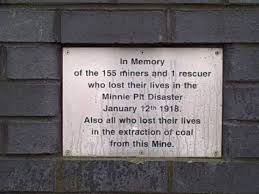
On the 12th January 1918 there was an explosion in the Bullurst seam, caused by a build-up of methane gas. The blast blew the coal dust on the roadways into the air which then ignited. There were 248 men and boys working underground and just 93 were saved. 11 were killed by the explosion and 144 died of carbon monoxide poisoning, making it the worst mining accident in Staffordshire. Several rescue teams came from Birchenwood, Silverdale and Burley Collieries and the Birchenwood Rescue Team Captain, Hugh Doorbar also died due to a faulty valve on his breathing apparatus. The disaster had a huge effect on the community. The colliery company paid each widow £5.00 per man and £1.00 per boy lost, £3.00 per coffin was added and wages were paid to the end of the week. A mere pittance by any standards.
Creswell Colliery Disaster – 1950.
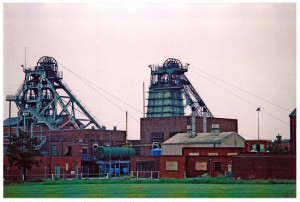
On Tuesday the 26th September a fire broke out at Creswell Colliery, Derbyshire, killing 80 men. This was caused by a jammed conveyor belt and when the fire broke out there were 131 men working in the vicinity. 51 men escaped but low water pressure made it difficult for the fire fighters to control the blaze. 3 bodies were recovered after which a meeting was held and it was decided to seal of that section of the mine containing the fire and it wasn’t until about a year later that all the bodies of the miners were recovered. They died of carbon monoxide poisoning and not from the fire.
Lofthouse Colliery Disaster – 1972.
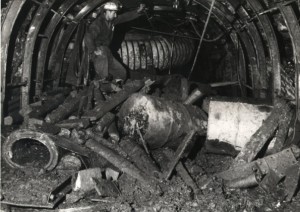
On the 21st March 1972 water surged into the South 9B district of Lofthouse Colliery. It came from a disused mineshaft sunk in 1831. It was known about but what wasn’t known was its depth and that it was full of water. As coal was cut from the face the water burst through sweeping everything in its path including heavy machinery. It blocked the main road way and the tailgate trapping 7 men underground. The rescuers had to drain the main roadway and get through a set of air-doors which were blocked with silt. There were over 200 men involved in the rescue and finally on the 27th March the rescuers broke through, only to find the body of Charles Cotton. At the end of the tailgate was a huge plug of mud and debris which blocked the way to the coal face and it was decided that it would be too dangerous to remove it for fear of causing further flooding. The remaining 6 bodies were left underground.
The talk went into much more detail, but this brief summary gives a flavour of the dangers that miners constantly faced. Soon the last pit will be closed on a world than none of us can imagine.
We must thank Anne for a very informative but moving and sombre talk.
More information about the National Coal Mining Museum can be gained at www.ncm.org.uk
